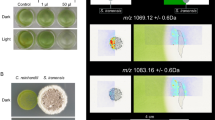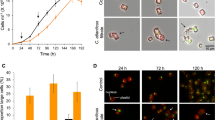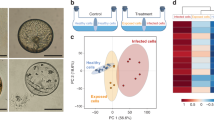Abstract
Emiliania huxleyi, an environmentally important marine microalga, has a bloom-and-bust lifestyle in which massive algal blooms appear and fade. Phaeobacter gallaeciensis belongs to the roseobacter clade of α-Proteobacteria, the populations of which wax and wane with that of E. huxleyi. Roseobacter are thought to promote algal growth by biosynthesizing and secreting antibiotics and growth stimulants (auxins). Here we show that P. gallaeciensis switches its secreted small molecule metabolism to the production of potent and selective algaecides, the roseobacticides, in response to p-coumaric acid, an algal lignin breakdown product that is symptomatic of aging algae. This switch converts P. gallaeciensis into an opportunistic pathogen of its algal host.
This is a preview of subscription content, access via your institution
Access options
Subscribe to this journal
Receive 12 print issues and online access
$259.00 per year
only $21.58 per issue
Buy this article
- Purchase on Springer Link
- Instant access to full article PDF
Prices may be subject to local taxes which are calculated during checkout




Similar content being viewed by others
References
Camilli, A. & Bassler, B. L. Bacterial small-molecule signaling pathways. Science 311, 1113–1116 (2006).
Schmidt, E. W. Trading molecules and tracking targets in symbiotic interactions. Nature Chem. Biol. 4, 466–473 (2008).
Clardy, J. Using genomics to deliver natural products from symbiotic bacteria. Genome Biol. 6, 232–235 (2005).
Shank, E. A. & Kolter, R. New developments in microbial interspecies signaling. Curr. Opin. Microbiol. 12, 205–214 (2009).
Scott, J. J. et al. Bacterial protection of beetle-fungus mutualism. Science 322, 63 (2008).
Oh, D. C., Poulsen, M., Currie, C. R. & Clardy, J. Dentigerumycin: a bacterial mediator of an ant-fungus symbiosis. Nature Chem. Biol. 5, 391–393 (2009).
Oh, D. C., Scott, J. J., Currie, C. R. & Clardy, J. Mycangimycin, a polyene peroxide from a mutualist Streptomyces sp. Org. Lett. 11, 633–636 (2009).
Currie, C. R. et al. Ancient tripartite coevolution in the attine ant–microbe symbiosis. Science 299, 386–388 (2003).
Gonzalez, J. M. et al. Bacterial community structure associated with a dimethylsulfoniopropionate-producing North Atlantic algal bloom. Appl. Environ. Microbiol. 66, 4237–4246 (2000).
Siegel, D. A. & Franz, B. A. Oceanography: century of phytoplankton change. Nature 466, 569–571 (2010).
Sabine, C. L. et al. The oceanic sink for anthropogenic CO2 . Science 305, 367–371 (2004).
Marsh, M. E. Regulation of CaCO(3) formation in coccolithophores. Comp. Biochem. Physiol. B Biochem. Mol. Biol. 136, 743–754 (2003).
Holligan, P. M., Viollier, M., Harbour, D. S., Camus, P. & Champagne-Phillippe, M. Satellite and ship studies of coccolithophore production along a continental shelf edge. Nature 304, 339–342 (1983).
Balch, W. M., Holligan, P. M., Ackleson, S. G. & Voss, K. J. Biological and optical properties of mesoscale coccolithophore blooms in the Gulf of Maine. Limnol. Oceanogr. 36, 629–643 (1991).
Holligan, P. M. et al. A biogeochemical study of the coccolithophore, Emiliania huxleyi, in the North Atlantic. Global Biogeochem. Cycles 7, 879–900 (1993).
Everitt, D. A., Wright, S. W., Volkman, J. K., Thomas, D. P. & Lindstrom, E. J. Phytophlankton community compositions in the western equatorial Pacific determined from chlorophyll and carotenoid pigment distributions. Deep Sea Res. A 37, 975–997 (1990).
Miller, T. R. & Belas, R. Motility is involved in Silicibacter sp. TM1040 interaction with dinoflagellates. Environ. Microbiol. 8, 1648–1659 (2006).
Kjelleberg, S. et al. Do marine natural products interfere with prokaryotic AHL regulatory systems? Aquat. Mirob. Ecol. 13, 85–93 (1997).
Joint, I. et al. Cell-to-cell communication across the prokaryote–eukaryote boundary. Science 298, 1207 (2002).
Rao, D. et al. Low densities of epiphytic bacteria from the marine alga Ulva australis inhibit settlement of fouling organisms. Appl. Environ. Microbiol. 73, 7844–7852 (2007).
Seymour, J. R., Simo, R., Ahmed, T. & Stocker, R. Chemoattraction to dimethylsulfoniopropionate throughout the marine microbial food web. Science 329, 342–345 (2010).
Matsuo, Y., Imagawa, H., Nishizawa, M. & Shizuri, Y. Isolation of an algal morphogenesis inducer from a marine bacterium. Science 307, 1598 (2005).
Keshtacher-Liebso, E., Hadar, Y. & Chen, Y. Oligotrophic bacteria enhance algal growth under iron-deficient conditions. Appl. Environ. Microbiol. 61, 2439–2441 (1995).
Geng, H., Bruhn, J. B., Nielsen, K. F., Gram, L. & Belas, R. Genetic dissection of tropodithietic acid biosynthesis by marine roseobacters. Appl. Environ. Microbiol. 74, 1535–1545 (2008).
Thiel, V. et al. Identification and biosynthesis of tropone derivatives and sulfur volatiles produced by bacteria of the marine Roseobacter clade. Org. Biomol. Chem. 8, 234–246 (2010).
Ashen, J. B., Cohen, J. D. & Goff, L. J. GC-SIM-MS detection and quantification of free indole-3-acetic acid bacterial galls on the marine alga Prionitis lanceolata (Rhodophyta). J. Phycol. 35, 493–500 (1999).
Hold, G. L., Smith, E. A., Birbeck, T. H. & Gallacher, S. Comparison of paralytic shellfish toxin (PST) production by the dinoflagellates Alexandrium lusitanicum NEPCC253 and Alexandrium tamarense NEPCC407 in the presence and absence of bacteria. FEMS Microbiol. Ecol. 36, 223–234 (2001).
Buchan, A., Gonzalez, J. M. & Moran, M. A. Overview of the marine roseobacter lineage. Appl. Environ. Microbiol. 71, 5665–5677 (2005).
Rao, D., Webb, J. S. & Kjelleberg, S. Competitive interactions in mixed-species biofilms containing the marine bacterium Pseudoalteromonas tunicata. Appl. Environ. Microbiol. 71, 1729–1736 (2005).
Greer, E. M., Aebisher, D., Greer, A. & Bentley, R. Computational studies of the tropone natural products, thiotropocin, tropodithietic acid, and troposulfenin. Significance of thiocarbonyl-enol tautomerism. J. Org. Chem. 73, 280–283 (2008).
Rosenberg, E., Koren, O., Reshef, L., Efrony, R. & Zilber-Rosenberg, I. The role of microorganisms in coral health, disease and evolution. Nat. Rev. Microbiol. 5, 355–362 (2007).
Lutgendorff, F., Akkermans, L. M. & Soderholm, J. D. The role of microbiota and probiotics in stress-induced gastro-intestinal damage. Curr. Mol. Med. 8, 282–298 (2008).
Delwiche, C. F., Graham, L. E. & Thomson, N. Lignin-like compounds and sporopollenin coleochaete, an algal model for land and plant ancestry. Science 245, 399–401 (1989).
Martone, P. T. et al. Discovery of lignin in seaweed reveals convergent evolution of cell-wall architecture. Curr. Biol. 19, 169–175 (2009).
Espineira, J. M. et al. Distribution of lignin monomers and the evolution of lignification among lower plants. Plant Biol. 13, 59–68 (2011).
Schaefer, A. L. et al. A new class of homoserine lactone quorum-sensing signals. Nature 454, 595–599 (2008).
Raes, J., Rohde, A., Christensen, J. H., Van de Peer, Y. & Boerjan, W. Genome-wide characterization of the lignification toolbox in Arabidopsis. Plant Physiol. 133, 1051–1071 (2003).
Boerjan, W., Ralph, J. & Baucher, M. Lignin biosynthesis. Annu. Rev. Plant Biol. 54, 519–546 (2003).
Rigby, J. H. & Zbur Wilson, J. Total synthesis of guaianolides: (+/–)-dehydrocostus lactone and (+/–)-estafiatin. J. Am. Chem. Soc. 106, 8217–8224 (1984).
Nair, V., Poonoth, M., Vellalath, S., Suresh, E. & Thirumalai, R. An N-heterocyclic carbene-catalyzed [8+3] annulation of tropone and enals via homoenolate. J. Org. Chem. 71, 8964–8965 (2006).
Ismail, W. et al. Functional genomics by NMR spectroscopy. Phenylacetate catabolism in Escherichia coli. Eur. J. Biochem. 270, 3047–3054 (2003).
MacDonald, M. J. & D'Cunha, G. B. A modern view of phenylalanine ammonia lyase. Biochem. Cell Biol. 85, 273–282 (2007).
Czichi, U. & Kindl, H. Formation of p-coumaric acid and o-coumaric acid from L-phenylalanine by microsomal membrane fractions from potato: evidence of membrane-bound enzyme complexes. Planta 125, 115–125 (1975).
Lee, Y. W., Jin, S., Sim, W. S. & Nester, E. W. The sensing of plant signal molecules by Agrobacterium: genetic evidence for direct recognition of phenolic inducers by the VirA protein. Gene 179, 83–88 (1996).
Gonzalez, J. M., Kiene, R. P. & Moran, M. A. Transformation of sulfur compounds by an abundant lineage of marine bacteria in the alpha-subclass of the class Proteobacteria. Appl. Environ. Microbiol. 65, 3810–3819 (1999).
Buchan, A., Neidle, E. L. & Moran, M. A. Diversity of the ring-cleaving dioxygenase gene pcaH in a salt marsh bacterial community. Appl. Environ. Microbiol. 67, 5801–5809 (2001).
Brinkhoff, T. et al. Antibiotic production by a Roseobacter clade-affiliated species from the German Wadden Sea and its antagonistic effects on indigenous isolates. Appl. Environ. Microbiol. 70, 2560–2565 (2004).
Wolfe, G. V., Steinke, M. & Kirst, G. O. Grazing-activated chemical defence in a unicellular marine alga. Nature 387, 894–897 (1997).
Wolfe, G. V. & Steinke, M. Grazing-activated production of dimethyl sulfide (DMS) by two clones of Emiliania huxleyi. Limnol. Oceanogr. 41, 1151–1160 (1996).
Newton, R. J. et al. Genome characteristics of a generalist marine bacterial lineage. ISME J. 4, 784–798 (2010).
Ashen, J. B. & Goff, L. J. Molecular identification of a bacterium associated with gall formation in the marine red alga Prionitis lanceolata. J. Phycol. 32, 286–297 (1996).
Lamy, D. et al. Temporal changes of major bacterial groups and bacterial heterotrophic activity during a Phaeocystis globosa bloom in the eastern English Channel. Aquat. Mirob. Ecol. 58, 95–107 (2010).
Cavender-Bares, K. K., Frankel, S. L. & Chisholm, S. W. A dual sheath flow cytometer for shipboard analyses of phytoplankton communities from the oligotrophic oceans. Limnol. Oceanogr. 43, 1383–1388 (1998).
Acknowledgements
The authors thank Shao-Liang Zheng at the Center for Crystallographic Studies, Harvard University, for solving the crystal structure of roseobacticide A, and Yoko Saikawa and Brenda N. Goguen for helpful discussions. The authors also thank the Chisholm laboratory for use of and help with their flow cytometer, and J.B. Dacks for assistance with bioinformatic analyses. M.R.S. is a Novartis Fellow of the Life Sciences Research Foundation. R.J.C. is a Harvard Ziff Environmental Fellow. This work was supported by the Office of Naval Research (grant N000141010447) and the National Institutes of Health (grants GM58213 and GM82137, R.K.; grants CA24487 and GM086258, J.C.).
Author information
Authors and Affiliations
Contributions
M.R.S., R.J.C, R.K. and J.C. designed the experiments and wrote the manuscript. M.R.S. performed roseobacticide isolation, structure elucidation and antibacterial assays. R.J.C. performed microscopy and flow cytometry for anti-algal activity assays.
Corresponding authors
Ethics declarations
Competing interests
The authors declare no competing financial interests.
Supplementary information
Supplementary information
Supplementary information (PDF 1290 kb)
Supplementary information
Crystallographic data for compound 6 (CIF 15 kb)
Rights and permissions
About this article
Cite this article
Seyedsayamdost, M., Case, R., Kolter, R. et al. The Jekyll-and-Hyde chemistry of Phaeobacter gallaeciensis. Nature Chem 3, 331–335 (2011). https://doi.org/10.1038/nchem.1002
Received:
Accepted:
Published:
Issue Date:
DOI: https://doi.org/10.1038/nchem.1002
This article is cited by
-
Bacteria contribute exopolysaccharides to an algal-bacterial joint extracellular matrix
npj Biofilms and Microbiomes (2024)
-
Algal blooms in the ocean: hot spots for chemically mediated microbial interactions
Nature Reviews Microbiology (2024)
-
Micrococcus lacusdianchii sp. nov., an attached bacterium inhibited by metabolites from its symbiotic algae
The Journal of Antibiotics (2024)
-
Meta-organism gene expression reveals that the impact of nitrate enrichment on coral larvae is mediated by their associated Symbiodiniaceae and prokaryotic assemblages
Microbiome (2023)
-
Aerobic bacteria produce nitric oxide via denitrification and promote algal population collapse
The ISME Journal (2023)



